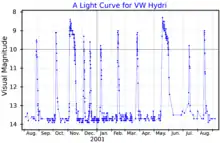| Observation data Epoch J2000.0 Equinox J2000.0 | |
|---|---|
| Constellation | Hydrus |
| Right ascension | 04h 09m 11.39s[1] |
| Declination | −71° 17′ 41.3″[1] |
| Distance | names= pc |

VW Hydri is a dwarf nova of the SU Ursae Majoris type in the deep southern constellation Hydrus; a star system that consists of a white dwarf and another generally cool star. It is one of the brightest dwarf novae systems in the sky.[3] These systems are characterised by frequent eruptions and less frequent supereruptions. The former are smooth, while the latter exhibit short "superhumps" of heightened activity.[4] The white dwarf sucks matter from the other star onto an accretion disc and periodically erupts, reaching apparent magnitude 8.4 in superoutbursts, 9.0 in normal outbursts and remaining at magnitude 14.4 when quiet. Normal outbursts occur every 27.3 days and last for 1.4 days, while superoutbursts happen 179 days and last for 12.6 days.[4][5]
References
- 1 2 "V* VW Hyi". SIMBAD. Centre de données astronomiques de Strasbourg. Retrieved 12 September 2013.
- ↑ "Download Data". aavso.org. AAVSO. Retrieved 1 October 2021.
- ↑ Vogt, N. (1974). "Photometric study of the dwarf nova VW Hydri". Astronomy and Astrophysics. 36: 369–78. Bibcode:1974A&A....36..369V.
- 1 2 BSJ (19 July 2010). "VW Hydri". AAVSO Website. American Association of Variable Star Observers. Retrieved 12 September 2013.
- ↑ Gänsicke, B. T.; Beuermann, K.; Thomas, H.-C. (1997). "EK TrA, a close relative of VW HYI". Monthly Notices of the Royal Astronomical Society. 289 (2): 388–92. Bibcode:1997MNRAS.289..388G. doi:10.1093/mnras/289.2.388.